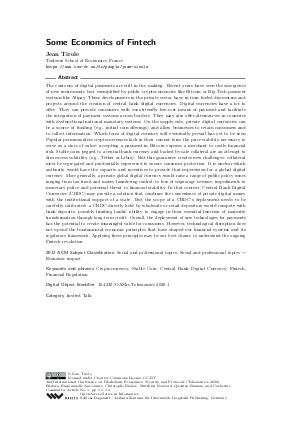Some Economics of Fintech (Invited Talk)
Author Jean Tirole
-
Part of:
Volume:
2nd International Conference on Blockchain Economics, Security and Protocols (Tokenomics 2020)
Part of: Series: Open Access Series in Informatics (OASIcs)
Part of: Conference: International Conference on Blockchain Economics, Security and Protocols (Tokenomics) - License:
 Creative Commons Attribution 3.0 Unported license
Creative Commons Attribution 3.0 Unported license
- Publication Date: 2021-02-02
File

PDF
OASIcs.Tokenomics.2020.1.pdf
- Filesize: 178 kB
- 1 pages
Document Identifiers
Subject Classification
ACM Subject Classification
- Social and professional topics
- Social and professional topics → Economic impact
Keywords
- Cryptocurrency
- Stable Coin
- Central Bank Digital Currency
- Fintech
- Financial Regulation
Metrics
- Access Statistics
-
Total Accesses (updated on a weekly basis)
0Document
0Metadata
Abstract
The contours of digital payments are still in the making. Recent years have seen the emergence of new instruments best exemplified by public cryptocurrencies like Bitcoin or Big Tech payment systems like Alipay. These developments in the private sector have in turn fueled discussions and projects around the creation of central bank digital currencies. Digital currencies have a lot to offer. They can provide consumers with user-friendly low-cost means of payment and facilitate the integration of payment systems across borders. They may also offer alternatives in countries with dysfunctional national monetary systems. On the supply side, private digital currencies can be a source of funding (e.g., initial coin offerings) and allow businesses to retain consumers and to collect information. Which form of digital currency will eventually prevail has yet to be seen. Popular permissionless cryptocurrencies lack in their current form the price stability necessary to serve as a store of value: accepting a payment in Bitcoin exposes a merchant to costly financial risk. Stable coins pegged to a central-bank currency and backed by safe collateral are an attempt to dim excess volatility (e.g., Tether or Libra). But this guarantee creates new challenges: collateral must be segregated and prudentially supervised to ensure consumer protection. It is unclear which authority would have the capacity and incentives to provide that supervision for a global digital currency. More generally, a private global digital currency would raise a range of public policy issues ranging from tax fraud and money laundering control, to loss of seignorage revenue, impediments to monetary policy and potential threat to financial stability. In that context, Central Bank Digital Currencies (CBDC) may provide a solution that combines the convenience of private digital money with the institutional support of a state. But the scope of a CBDC’s deployment needs to be carefully calibrated: a CBDC directly held by wholesale or retail depositors would compete with bank deposits, possibly limiting banks’ ability to engage in their essential function of maturity transformation through long-term credit. Overall, the deployment of new technologies for payments has the potential to create meaningful value for consumers. However, technological disruption does not upend the fundamental economic principles that have shaped our financial systems and its regulatory framework. Applying these principles may be our best chance to understand the ongoing Fintech revolution.
Cite As Get BibTex
Jean Tirole. Some Economics of Fintech (Invited Talk). In 2nd International Conference on Blockchain Economics, Security and Protocols (Tokenomics 2020). Open Access Series in Informatics (OASIcs), Volume 82, p. 1:1, Schloss Dagstuhl – Leibniz-Zentrum für Informatik (2021)
https://doi.org/10.4230/OASIcs.Tokenomics.2020.1
BibTex
@InProceedings{tirole:OASIcs.Tokenomics.2020.1,
author = {Tirole, Jean},
title = {{Some Economics of Fintech}},
booktitle = {2nd International Conference on Blockchain Economics, Security and Protocols (Tokenomics 2020)},
pages = {1:1--1:1},
series = {Open Access Series in Informatics (OASIcs)},
ISBN = {978-3-95977-157-3},
ISSN = {2190-6807},
year = {2021},
volume = {82},
editor = {Anceaume, Emmanuelle and Bisi\`{e}re, Christophe and Bouvard, Matthieu and Bramas, Quentin and Casamatta, Catherine},
publisher = {Schloss Dagstuhl -- Leibniz-Zentrum f{\"u}r Informatik},
address = {Dagstuhl, Germany},
URL = {https://drops.dagstuhl.de/entities/document/10.4230/OASIcs.Tokenomics.2020.1},
URN = {urn:nbn:de:0030-drops-135239},
doi = {10.4230/OASIcs.Tokenomics.2020.1},
annote = {Keywords: Cryptocurrency, Stable Coin, Central Bank Digital Currency, Fintech, Financial Regulation}
}
